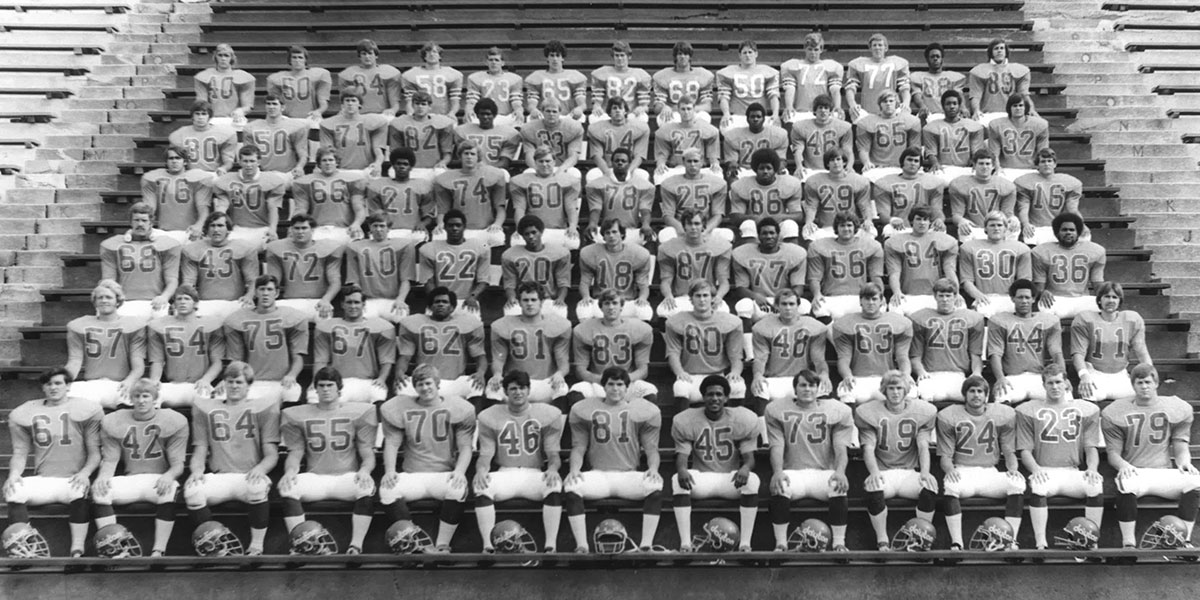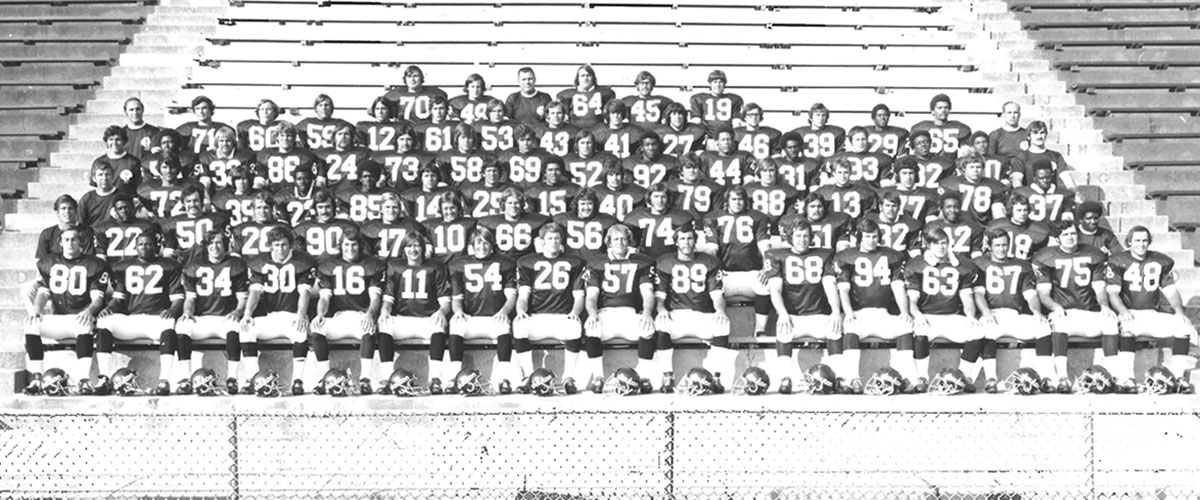Forever on the field
Fifty years ago, a 20-year-old University of Dayton football player with an immense love for life had that life cut short in the most tragic of ways.
On a November afternoon in 1972, junior defensive tackle Matt Dahlinghaus suffered what would be a fatal injury during a Flyer football game at Bowling Green. He died a month later at St. Elizabeth’s Hospital in Dayton.
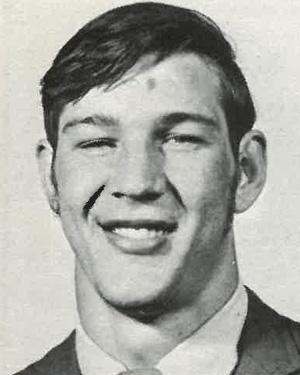
In the half-century since his death, the teammates and family members Dahlinghaus left behind have remained close. They come together regularly to celebrate his life and his impact on theirs — and also to celebrate the spirit he embodied and that’s still carried on today by Flyer student-athletes.
Now in their late 60s and early 70s, these friends and family will be back on campus again Oct. 28-29 for a 50th anniversary tribute weekend highlighted by the dedication of a permanent memorial to Dahlinghaus on the UD football practice field.
“It’s amazing he’s still being remembered 50 years later and that he made that much of an impact on so many,” said Beth Dahlinghaus Conway ’71, his older sister. “The weekend gives us another chance to share those memories. While it can be painful, it’s also exhilarating to hear what they have to say about my brother and think, ‘Wow, they really loved him, too.’”
While the new memorial provides a visual testimony to Dahlinghaus’ influence on UD athletics, the University has honored his legacy for decades. Former Flyer student-athletes in the Varsity D social club contributed to a scholarship in Dahlinghaus’ name shortly after his death, and the Matt Dahlinghaus Memorial Scholarship continues to support student-athletes 50 years later.
Honorees have included Rick Chamberlin ’80, UD’s head football coach for the past 15 years, who used the scholarship to fund his master’s degree studies while working as a football graduate assistant.
“For us to be able to honor someone from 50 years ago, it shows they’re still part of this family.”
“It's a very special weekend for us because we're honoring one of us,” Chamberlin said. “We talk about the Flyer football family and the links that connect all of us — there’s an actual chain link we give to alumni players to put on their keychain to show they’re connected to this program. For us to be able to honor someone from 50 years ago, it shows they’re still part of this family.”
A life well lived
At 6-foot-4 and “190 pounds soaking wet, maybe,” Dahlinghaus was not the prototypical defensive tackle, said Tim Quinn ’73.
What he lacked in size, he more than made up for in speed.
“He was like a rubber band,” said Quinn, who played linebacker and defensive tackle. “I remember being on the field and these big tackles would try to block him and he would outmaneuver them. They'd look around and he'd have the quarterback sacked. He had a motor that never quit running.”
Relentless was how Ralph Bierdeman ’74 described Dahlinghaus, and Bierdeman watched in amazement during preseason practices as Dahlinghaus channeled his fierce competitiveness to beat out bigger and stronger players to earn a starting position.
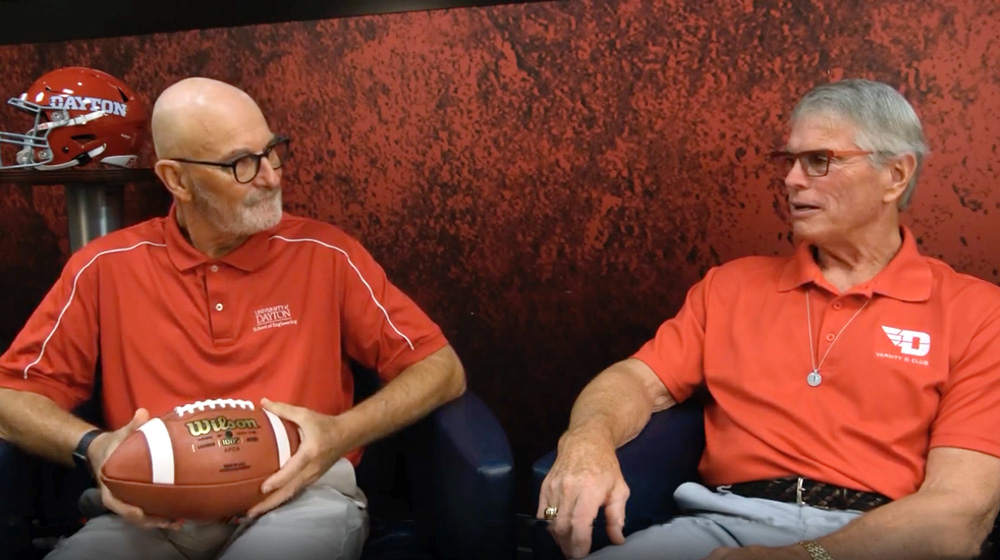
Even then, he did it with joy.
“If he got knocked down, he probably just laughed about it,” said Bierdeman, who came to UD as a defensive back and moved to wide receiver/tight end. “He had character traits I admire to this day. There are people in life that suck energy from you and others that give you energy. He was a source of energy. He didn't do anything other than be who he was, but I think there was a lot of leadership there that would just inspire you.”
And he lived his life off the field the same way he played — full of energy, cagey, unpredictable and sometimes with reckless abandon.
“I never saw Matt with anything but a smile,” Quinn said. “Even in summer practice, he was fun. He was a little bit goofy, which made it more fun to be around him, but he was just very unique and just a joy to be with.”
Dahlinghaus grew up in a family of six children in Dayton, and Conway remembers her brother as a person never able to sit still, almost like an “adult leprechaun.” As kids, they’d climb roofs at night and sneak to the Stanley Street Bridge to ride bikes, despite their mother explicitly forbidding them to do so.
Conway laughs about some of her brother’s antics at UD, including a time during his freshman year when he lived in Founders Hall with other football players. He asked his sister if he could throw a party at the off-campus house she shared with other female classmates. Conway told him and teammate Chip Bok ’74 they could do so only if they promised to clean up the house — which thankfully, they did.
Bok, a walk-on tailback and hockey team captain, has stories of their shenanigans as well, from hitchhiking to Athens, Ohio, to watch a friend’s football game, to Dahlinghaus strapping on a pair of skis for the first time while visiting Bok’s family’s cottage in Indiana. Never to do anything halfway, Dahlinghaus went straight for the slalom.
“He was just such an unusual, enthusiastic player with a great sense of humor,” Bok said. “Anything he did was done full bore … and he was damn good at it.”
A play gone wrong
UD was still a Division I scholarship program in the early 1970s, playing schedules featuring teams such as Louisville, Cincinnati, Toledo, Bowling Green, Ohio, Marshall and Xavier. In 1972, the Flyers had a 4-4-1 record as they prepared for their second-to-last game of the season, a Nov. 11 road contest against Bowling Green.
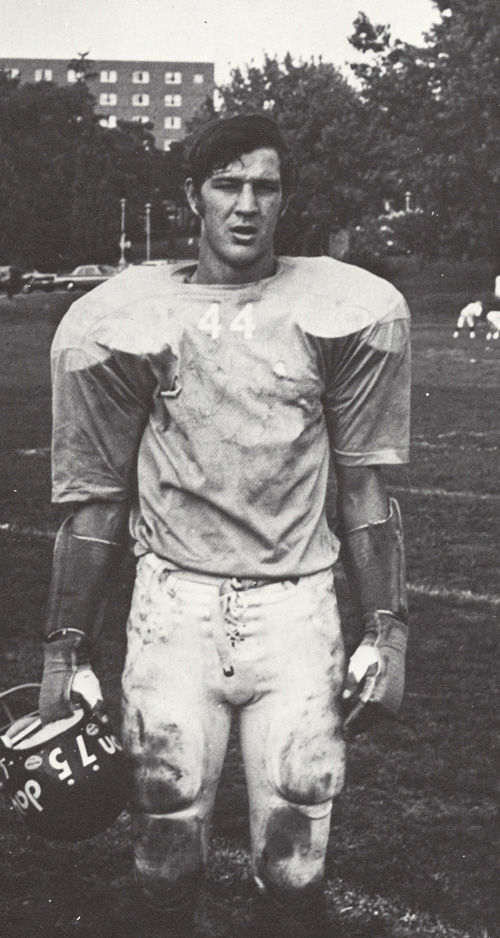
Dahlinghaus and Quinn were hotel roommates when UD traveled for road games. One of Quinn’s last memories of Dahlinghaus was the pregame meal they shared – an early ’70s, New Age-style lunch of honey, toast and tea consumed on the floor of their hotel room, with incense burning to set the mood.
As a defensive lineman, Quinn was on the field when the play happened, with Quinn playing on the right side and Dahlinghaus on the left. The Bowling Green halfback was carrying the ball on a sweep, and Quinn saw Dahlinghaus make the tackle. Nothing appeared out of the ordinary, and players peeled one by one from the pile on the ground to set up the next play.
Dahlinghaus remained still.
Quinn thought he might have suffered a concussion or was briefly knocked out, but his eyes were open and he was breathing. He just couldn’t move.
“It was an off-tackle play,” Bierdeman said. “Everybody gets up, and Matt didn't get up. The doctor's looking at him and says, ‘We need an ambulance.’ You're sitting there and they're not sharing news, but you see them put him on a board and take him out. Bowling Green is right along I-75, so the ambulance pulls out and gets right on the highway. I still remember the ambulance driving north toward Toledo, the lights on and the sirens going.”
Nothing else mattered that day, Bierdeman said, and he doesn’t remember anything from the remainder of the game, other than the final score being 5-0, with Bowling Green winning with a field goal and a safety. The score didn’t matter and the loss was immaterial — the players were still trying to process what happened to their teammate.
“It’s a hard memory to talk about, but that’s what happened that day,” Quinn said. “I still don’t like to drive past that stadium. I close my eyes if I’m not driving. The memory is still too fresh.”
“I still don’t like to drive past that stadium. ... The memory is still too fresh.”
They’d later learn Dahlinghaus had broken his neck and had been immediately paralyzed from the neck down. He remained in a Toledo hospital until late December, his head stabilized in a cervical halo and surviving on a ventilator. A tracheotomy was performed to help with breathing.
Teammates visited often. Bok borrowed a car from Ken Leighton ’74 to drive to Toledo. He remembered seeing Dahlinghaus’ family and athletics director Tom Frericks there as well.
“I didn’t realize how bad it was until I got there,” Bok said. “The most frustrating thing for him was that he couldn’t talk or move his arms. That was just hard for him.”
Shortly before Christmas, Dahlinghaus was flown to St. Elizabeth’s Hospital in Dayton after suffering complications. Even then, Conway remembered how he tried to remain positive and keep the same energy he’d had throughout his life thus far. With his voice barely a whisper, he talked about what he planned to do once he was released from the hospital. If he could regain some movement, he said, he’d take up wheelchair basketball.
Her husband, Mike Conway, had known Dahlinghaus from Dayton Catholic high school football circles, as Mike Conway played at Alter and Dahlinghaus played for Chaminade. He asked Dahlinghaus how he was doing during a visit shortly after Christmas.
“Oh forget about me, I’m fine,” Mike Conway said Dahlinghaus replied. “How are you?”
Mike Conway asked him if there was anything he could get for him.
“Yeah, I’d like a beer.”
Mike Conway said they all knew Dahlinghaus was in no condition to drink anything, let alone a beer, but the fact his sense of humor never wavered provided a moment of levity. He was still Matt.
That would be one of his last interactions with friends and family. Shortly after the Conways’ visit, Dahlinghaus suffered a pulmonary embolism when a blood clot emerged in his lungs. He died Dec. 28, 1972.
Bok remembers coming home from a family trip to Lake Placid, New York, where his brother was playing hockey, and his father simply showing him the newspaper.
“You don’t forget something like that,” Bok said. “It was so shocking, so sudden. Kids that age don’t just die and especially in a football game. It’s not something you’d ever expect.”
That was a common sentiment as word spread through the program. Dahlinghaus’ tragic ending would be the first encounter with death for most of the players, all young men just entering their 20s.
“I never saw an injury where somebody just couldn't be helped off the field,” Bierdeman said. “Players get hurt, you have lots of injuries, but nothing like that. When he was in the hospital, we’re just hoping he’d recover and go on with life, and then you hear the news. ... I was probably 20 years old. I had nothing to prepare me to cope with that. I still kind of feel that way. There was no chance to say goodbye. We all shared a common loss that day.”
‘What Matt left us’
That common loss forged bonds between the players, the Dahlinghaus family and UD that remain solid today.
Conway remembers how Frericks and his wife visited her parents’ home shortly after the accident, sitting in the living room and vowing to the family that UD would take care of them. That included answering phone calls and passing on messages to alleviate the family’s burden as they cared for their son, to later extending Dahlinghaus’ scholarship to a younger brother, Patrick, who would graduate from UD in 1976 with a bachelor’s degree in physical education.
Family members also received basketball tickets in the third row from the floor at UD Arena, and Dahlinghaus’ parents were invited every year to the scholarship dinner to meet the recipients.
“UD was more like a family to us than just an institution or college,” Conway said.
“UD was more like a family to us than just an institution or college.”
Through Varsity D, former student-athletes helped launch the Matt Dahlinghaus Memorial Scholarship, first awarded to football players and now given annually to an exemplary student-athlete from any sport. The names of those who funded the scholarship are etched on the 8-foot memorial, along with a written tribute to Dahlinghaus as a player, teammate and friend.
The scholarship keeps alive the belief that Flyer athletics both attracts and assists student-athletes in becoming their best selves — for their team and for the community.
“I think we all have one or more Matt Dahlinghauses in our life,” said Bierdeman, one of the players who contributes to the scholarship. “And we've got a close-knit network of teammates that I’m still in touch with. If you need something, they're there.”
And UD’s former student-athletes continue to give. Just days ago, an anonymous donor announced a match of the first $10,000 in additional contributions to the fund made by Dec. 31.
“It’s amazing to know how so many people talk about Matt, his memory and his significance in our lives,” Bierdeman said. “We still honor Matt's memory and who he was as a teammate and a friend. I hope that means something to folks who may be future recipients of the scholarship, or just know of its history and why it exists. That inspires me — and I think it can inspire a lot of other people.”
“We still honor Matt’s memory and who he was as a teammate and a friend.”
It inspired Chamberlin, who arrived at UD just a few years after Dahlinghaus’ death. He knew how Dahlinghaus’ passion for the game helped him succeed at UD and said that level of enthusiasm for the game is what keeps UD football — and the entire athletics program — successful 50 years later. As one of the earliest recipients of the scholarship, Chamberlin remains appreciative of how it helped him start his career.
“As a graduate assistant, you have some football knowledge, but the coaching and the teaching knowledge is something that you have to learn, along with game preparation and recruiting that are so important to the profession,” Chamberlin said. “Because of the Dahlinghaus scholarship, I was able to accept the position because of the financial resources it offered, and I was able to work on my master’s degree.”
Quinn also talked about the legacy Dahlinghaus left to his teammates in multiple ways. Although Quinn was already on a premed track while playing football at UD, he decided to pursue orthopedic surgery after graduation to work with athletes recovering from injuries.
“Honestly, Matt’s story inspired me,” Quinn said. “In 1989, I got a call from Don Donoher and he said, ‘Dr. Quinn, would you like to help with the basketball team?’ I would do anything to help out UD athletics, and that blossomed into Mike Kelly asking me to help the football team. For 21 years, I was a team doctor and an orthopedic consultant for UD athletics. It was wonderful. I was blessed to do that.”
The legacy even continues through a bumper crop of Matts now in their late 30s and early 40s. They’re the sons of former Flyer football players or family members — like Matt Dailey, the son of linebacker Don Dailey ’74; Matthew Michael Conway, Mike and Beth’s son; and Matt Bok, Chip’s son.
“I wanted him to have an enthusiasm for life, just like Matt Dahlinghaus did,” Bok said.
A nationally syndicated cartoonist for the Akron Beacon Journal, Bok has sketched multiple comics for team reunions, including one for the 25th anniversary gathering depicting some of the players and Dahlinghaus on the golf course. Dahlinghaus, depicted as a 20-year-old, laughs as he glances at his now-older teammates.
“You look like hell,” the cartoon quotes.
Bok jokes they all probably look worse today. Maybe he’ll riff on that older comic if he draws another one for their 50th anniversary gathering in a few weeks.
“I’m looking forward to it — it will be great to see all of the guys who’ll be there,” Bok said.
“And Matt. I’m sure he’ll be there too.”
Events will be held Oct. 28 and 29, 2022, to commemorate the life of Matt Dahlinghaus
Friday, Oct. 28 • A 4 p.m. Flyer football practice at Von Mohr practice field will be followed by a reception at 5:30 p.m. in Boesch Lounge at UD Arena. Reception will include updates on the Dayton football program and the Matt Dahlinghaus Memorial Scholarship and a sharing of memories by friends and family.
Saturday, Oct. 29 • Tailgate hosted by Varsity D will begin at 11 a.m., followed by the 1 p.m. game versus Valparaiso.
To attend either day, RSVP to Robby Poteat, senior associate athletic director, at rpoteat1@udayton.edu or 937-229-5207. To contribute to the Matt Dahlinghaus Memorial Scholarship fund, click here.
Matthew Dahlinghaus Memorial Inscription
“Matt embodied all the best qualities of a student-athlete. He was both an avid learner and headstrong competitor. A tall, lanky, 195 pound junior defensive tackle, he made up for it due to his relentless style of play. A scholarship, established in Matt’s name, will go on in his memory, providing opportunities for student-athletes who represent the leadership qualities that Matt possessed. Gone but not forgotten, we remember and celebrate Matthew Dahlinghaus.”